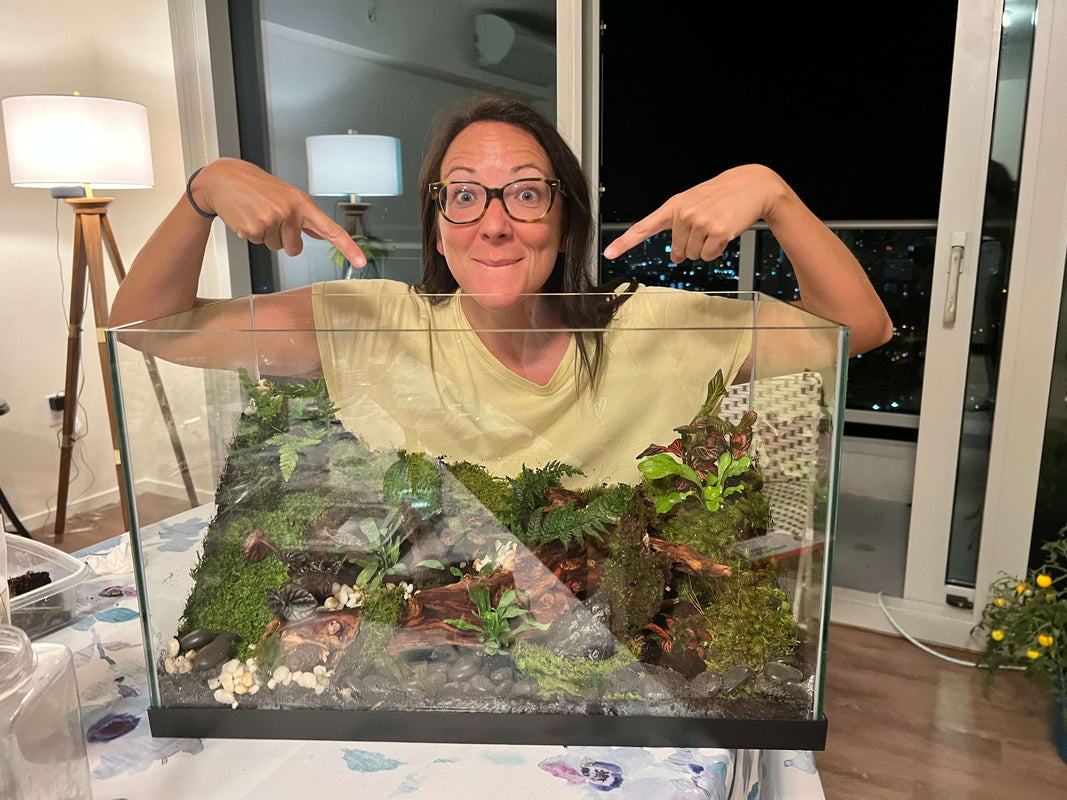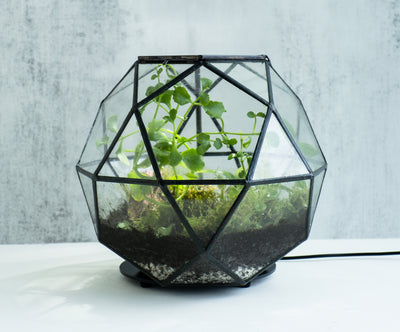In this post you will learn how to make and maintain a bioactive terrarium, in a glass container that is a self contained ecosystem. This type of terrarium combines plants, animals and microorganisms to regulate its own balance. It covers the components of a bioactive setup and how to make one.
Summary
-
A bioactive terrarium is a self contained ecosystem with plants, microfauna and beneficial microorganisms to mimic natural processes.
-
The key to a thriving bioactive terrarium is a well made substrate that holds moisture, supports plant growth and facilitates nutrient cycling.
-
Bioactive terrariums need regular maintenance, monitoring humidity, managing plant growth and controlling pests to keep the environment balanced.
What is Bioactive Terrarium

A bioactive terrarium is a self contained ecosystem in a glass or plastic enclosure. By adding plants, animals and beneficial microorganisms this setup tries to mimic the natural processes in the wild, to produce an environment that can sustain itself. The goal here is to have a system where the waste produced in the terrarium decomposes and gets cycled back by the entities within it. So we don’t have to manage and maintain as much.
When making your own bioactive terrarium, understanding what makes an ecosystem sustainable is key—this means choosing an enclosure size that can accommodate the living needs of the species you want to keep.
If done correctly with all the components in place—a well thought out selection of species and their microorganisms—the bioactive terrarium will be not only beautiful but also functional. It has built in mechanisms to clean and refresh itself without much external help.
Bioactive Terrarium Components
A bioactive setup is anchored by the bioactive substrate which must hold moisture but also allow drainage and oxygen flow. Making a bioactive substrate mix involves creating a drainage layer at the bottom, then a rich substrate layer and finally a layer of leaf litter. Rocks or leca are used as the drainage layer at the bottom to prevent water logging in the terrarium.
The next layer is organic materials like sphagnum moss and potting soil that combines to become the habitat for beneficial microbes and microfauna. These organisms break down waste into simpler forms that revitalize and enrich the soil with nutrients. A layer of leaf litter on top provides food but also hides the niches for these tiny creatures and contributes to the overall health of this mini-ecosystem.
In this terrarium setup, critters like springtails and isopods are the cleanup crew. They break down the detritus – recycle it back into food sources for the plants to uptake – to maintain balance for an environment to thrive.
Bioactive Substrate

A well made bioactive substrate is key to a self contained terrarium as it feeds and supports both plants and small creatures by cycling nutrients. This often includes earthworm castings that are rich in nutrients to improve the overall health of the substrate.
Bacteria and fungi are key. They break down organic matter and support plant root growth. These microorganisms not only promote healthy roots but also food for the inhabitants of the terrarium so the ecosystem is always dynamic and self sufficient.
Bioactive Substrate Mix
Choosing the right bioactive substrate mix is important for a thriving terrarium ecosystem. This mix should support plant growth and beneficial microorganisms. For those new to bioactive setups, starting with pre-made kits is a good idea.
To recycle nutrients and establish stability, the substrate in your terrarium must be balanced. This is good for plants and microfauna. Whether you use pre-made mixes or make your own, this layer is the key to a thriving bioactive terrarium system.
Common Bioactive Substrate Ingredients
ABG mix is commonly used in bioactive substrates for its ability to support plant growth and a thriving ecosystem. Coco coir and sphagnum moss are great for holding water so they are good choices for the substrate layer.
To get good drainage and airflow in this environment, orchid bark and charcoal must be included. These materials help establish balance in the habitat which is good for many plants and microfauna.
Customizing Your Bioactive Substrate Mix
Customize your bioactive substrate mix to the specific biome you are working with. Adjust the organic matter content and the draining elements to suit your plants and microorganisms.
Adding activated carbon helps with gas exchange, so roots stay oxygenated, which prevents soil compaction and promotes root growth and microbial activity. A balanced bioactive substrate supports self contained cycles and the intricate relationships between plants, microfauna and microflora.
Setting up Your Bioactive Terrarium
Setting up a bioactive terrarium requires some preparation, start with choosing the right container. Containers that are closed or have a glass or plastic lid are best for a bioactive environment as they help retain moisture and create a consistent microclimate.
Once you have your container, assemble the substrate layers and add microfauna and flora to the setup. The final step is to plant and decorate your terrarium so it becomes a self contained ecosystem.
Layering the Substrate
In a bioactive terrarium, you must start with a drainage layer. This layer prevents water from pooling and prevents root rot and other problems. Common materials for this layer are leca (lightweight expanded clay aggregate), stones or professionally made substrates designed for drainage.
After the moisture management system is in place with the drainage base, add your bioactive substrate mix on top. This mix must have the ability to hold moisture but also allow air to flow. This is important for plant health and growth in the enclosure. Finish this setup by scattering leaf litter on top of your substrate blend. This top dressing provides food and hiding places for microorganisms that are key to the balance and vitality of your bioactive ecosystem.
Adding Microfauna and Microflora
Adding microfauna like isopods and springtails is crucial to a bioactive terrarium. These tiny creatures eat waste and mold and recycle nutrients back into the soil and break down organic matter. In this cycle detritivores like earthworms, isopods and springtails are essential.
Introducing beneficial microorganisms like mycorrhizal fungi will boost plant vitality by competing against bad fungal species and stimulating root growth. A clean up crew in your terrarium ensures waste decomposition and nutrient cycling happens efficiently to maintain a balanced ecosystem.
Planting and Decorating

To have a thriving ecosystem in your terrarium, choose plants that are suitable for your setup. For smaller terrariums, miniature plants like those used in model railroad scenery may be enough. Larger enclosures can have more plant species.
Use potting soil or coco coir as the base medium for planting, it will provide nutrients and good drainage – both important for plant growth. Match each plant’s light and water requirements when creating their new environment in the terrarium. Add stones and wood branches to your design and you will not only get visual appeal but also hiding places and stimulation for the creatures inside.
Having live plants in your decorated terrarium helps to maintain a healthy ecosystem and gives you the satisfaction of creating and caring for it – and it’s beauty will last. Check out recommended terrarium plants
Caring for Your Bioactive Terrarium
To maintain the balance of the ecosystem, you must regularly inspect and maintain a bioactive terrarium. Although these enclosures require less cleaning than regular terrariums, maintenance is still important for the well being of flora and fauna inside.
In a bioactive system live plants absorb nitrogen rich waste which makes the environment healthier. Using different detritivores helps to control waste and organic debris and maintain a robust and thriving ecosystem.
Humidity and Watering
Humidity control is important for plant health and the overall terrarium ecosystem. Lighting conditions not only promote plant growth but also benefits all living things in the terrarium.
Watering needs vary from one plant species to another. Adjust your watering according to each species’ needs. Give your bioactive setup at least a month to stabilize before adding inhabitants and that will help establish a microclimate and humidity levels for optimal growth. Read our terrarium care article
Plant Growth and Health
To prevent plants from outgrowing the terrarium, ensure good airflow, remove unhealthy parts and promote overall plant health, minor pruning is necessary.
Plant health requires soil nutrient refresh with organic fertilizers. Clean up organisms and plants need moisture for survival and thriving in the ecosystem.
Pests and Diseases
Maintaining humidity levels is important to prevent mold growth and plant health. While microfauna helps with waste management, big buildup may require physical intervention to avoid health problems.
Using natural predators as part of integrated pest management will help control infestation without disrupting the ecosystem. These methods will keep pest numbers in check and maintain the balance of the environment.
Advantages of Bioactive Terrariums
Bioactive setup is an environment that is beautiful and beneficial for plants and animals. It’s an autonomous ecosystem that reduces the need for regular cleaning because of the natural waste decomposition process mediated by tiny invertebrates.
To add depth and functionality to the enclosure rocks and branches provide hiding places for the animals making the environment more natural. Although maintenance is still important these bioactive enclosures require much less maintenance than regular habitats.
Conclusion
Setting up a bioactive terrarium requires knowledge of creating a self sustaining ecosystem, choosing the right mix of substrates and assembling the terrarium. Continuous care will ensure the well being of the plants and animals inside. It’s worth the effort to have a balanced ecosystem.
Whether you’re an experienced enthusiast or a beginner there’s no greater joy than seeing your own bioactive terrarium thrive. Start now and bring a piece of nature into your living space.
FAQs
What is a bioactive terrarium?
A bioactive terrarium is a mini ecosystem where beneficial microorganisms, plants and animals work together to break down waste. This symbiotic relationship creates balance in the terrarium making it self sustaining.
In short it’s like having a piece of nature in a glass jar!
Why bioactive substrate?
The bioactive substrate is important because it promotes plant growth by having beneficial microbes and thus a healthy and balanced ecosystem.
It also helps in nutrient cycling which in turn makes the plants more robust and vigorous.
What are the common ingredients in bioactive substrate?
ABG mix, coco coir, sphagnum moss, orchid bark and charcoal are common ingredients in bioactive substrate.
Mixing these together will create a habitat for your plants and critters to flourish!
How to maintain a bioactive terrarium?
Monitoring the conditions inside your bioactive terrarium is key to its health. This includes trimming back excessive plant growth, replenishing soil nutrients and keeping an eye on humidity to maintain the environment.
By doing so you will have a robust ecosystem for your flora and fauna.
What are the advantages of bioactive terrarium?
A bioactive terrarium requires less cleaning and has a lush environment that’s beautiful for the plants and animals inside, and itself.
This approach to your setup results in benefits all around!

